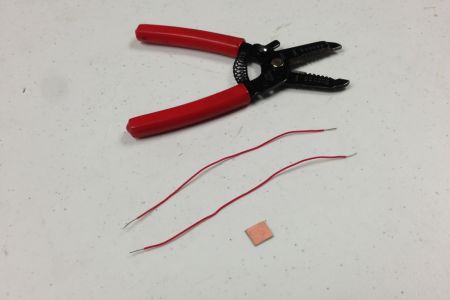Overview & materials

The battery interrupt is a component that sits between a battery operated device and a capability switch, it allows a capability switch to control the ON & OFF of a battery device such as a toy or radio. The device “interrupts” the battery’s flow of electricity using double sided copper clad which is typically used for electronic circuit boards.
The battery interrupt accepts the standard 1/8″ (3.5mm) mono plug used with switches. Using a capability switch, a person might use their head to control a toy or their fingers or feet to activate a small fan.
Double sided copper clad is just like a sandwich, a piece of non conductive silicon wafer is sandwiched between two pieces of thin copper, the copper pieces are not touching. Electronic circuit board use this material to print double sided circuits.
To make the battery interrupt we will do the following:
- Cut a small piece of copper clad or cooper sheeting
- Solder one wire to each side of the copper.
- Test inside battery device.
- Solder an accessibility jack to the opposite end of the wires.
- Insert inside battery device, test with switch.
Materials required
- Copper – either copper sheet and thin cardboard OR double sided copper clad.
- 1/8″ (3.5mm) mono audio jack
- Hook up wire (22 gauge)
- Wire cutters/strippers
- Soldering iron, solder and helping hands
Want to try this at home? Purchase one of our component kits for $9.99
Cutting & prepping copper clad
We’ll start with the copper clad example.
Cut out two small squares of copper clad using the wire cutting part of your wire strippers (usually located at near the joint of the tool). You will hear some crunching sounds and feel resistance, this is the silicon wafer you are cutting through.
The squares will have sharp edges until cleaned up – take care while handling them.


Alternate: Copper foil sheets/tape instead of copper clad
Cut two squares from copper sheet
The idea is the same with copper foil sheets, using scissors cut two small squares of copper. It is probably best to use older scissors to not dull your good pair.


Cut a square of cardboard
Next we will prepare the insoluator from cardboard. Cut an identical square from a small piece of cardboard the thickness of a postcard or cereal box top is preferred.
This cardboard will be sandwiched between the two copper squares below.

Make a copper-cardboard-copper sandwich
Using double sided tape, put the copper squares on either side of the cardboard. Trim the final square to make edges even.


Soldering wire to copper & testing
Prepare wires
Cut two wires about six inches in length. Strip 1/4″ of plastic from wire on each end.



Position copper and wire for soldering
Plug your soldering in now.
Using helping hands position the copper clad and wire. Only the stripped part of the wire should be touching the copper.

Gently touch the soldering iron to the stripped wire to heat it. Touch solder to stripped wire. Solder should melt and cover wire and copper.


Soldering the 2nd wire
Flip the copper clad over and prepare second wire. Solder second wire to backside of copper clad.

Final product should have a small solder joint connecting the wires and copper clad on each side. The wires should not wiggle on the copper.

Test the batter interrupt
Put the battery interrupt into a battery operated toy, this toy uses a C battery, The positive end ( + ) will touch one side of the copper clad, the other side of copper clad will touch the toy’s battery connector.
Turn the toy’s switch ON, with the copper clad in place the toy should not operate. Touch the two wires to activate the toy. Did it work? If so, congrats! If not, double check that the battery interrupt has one side touching the battery and the other side touching the battery holder.
TIP – for some toys, it is easier to install the battery first, slide the battery towards the negative side so a gap opens near the tip of the battery. Slide battery interrupt into the gap between the + end and the toy’s connector.
Wiring & connecting switch jack to copper clad
Connecting the switch jack
Take the 1/8″ (3.5mm) female switch jack, identify the tabs that will be connected. This particular switch jack has 3 tabs, we will connect a wire to two of them, the tabs on either side, skipping the middle tab.

Bend and hook it
To connect, bend the wire into a hook and thread it through a tab on the switch jack.



Use helping hands to hold switch jack and wire
With the tabs tightly hooked, fasten the switch and the wire to the helping hands. The wire should be pulled tight so the wire is touching the side of the tab.
Solder the wire and tab together.


After finished with the first wire and tab flip the jack and solder the second tab and wire.

With both wires soldered to the switch jack, the solder pads should be small and the wires should not wiggle. (the middle tab is unused with this particular jack)

